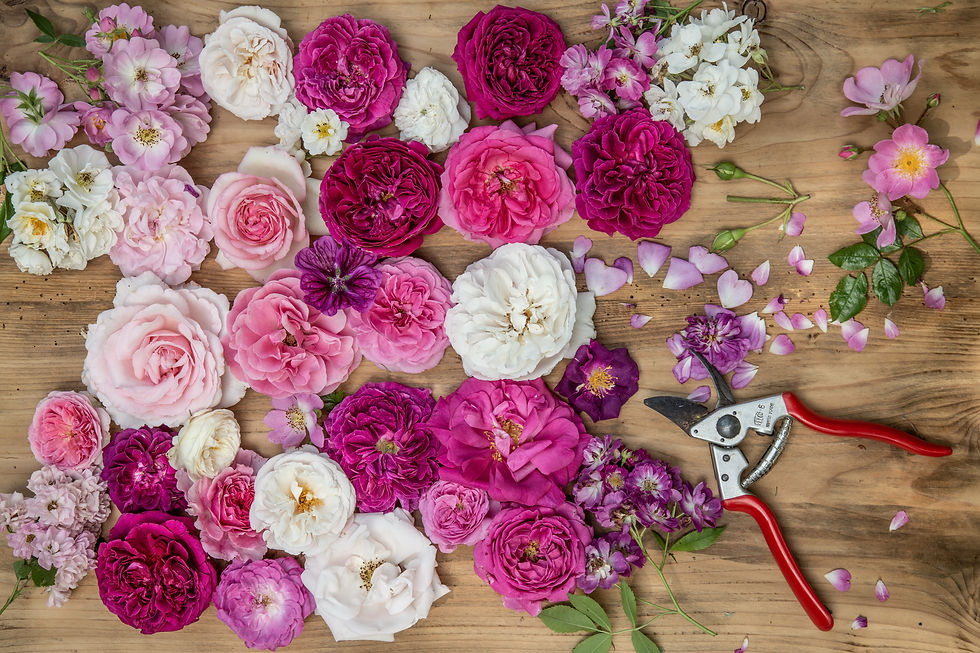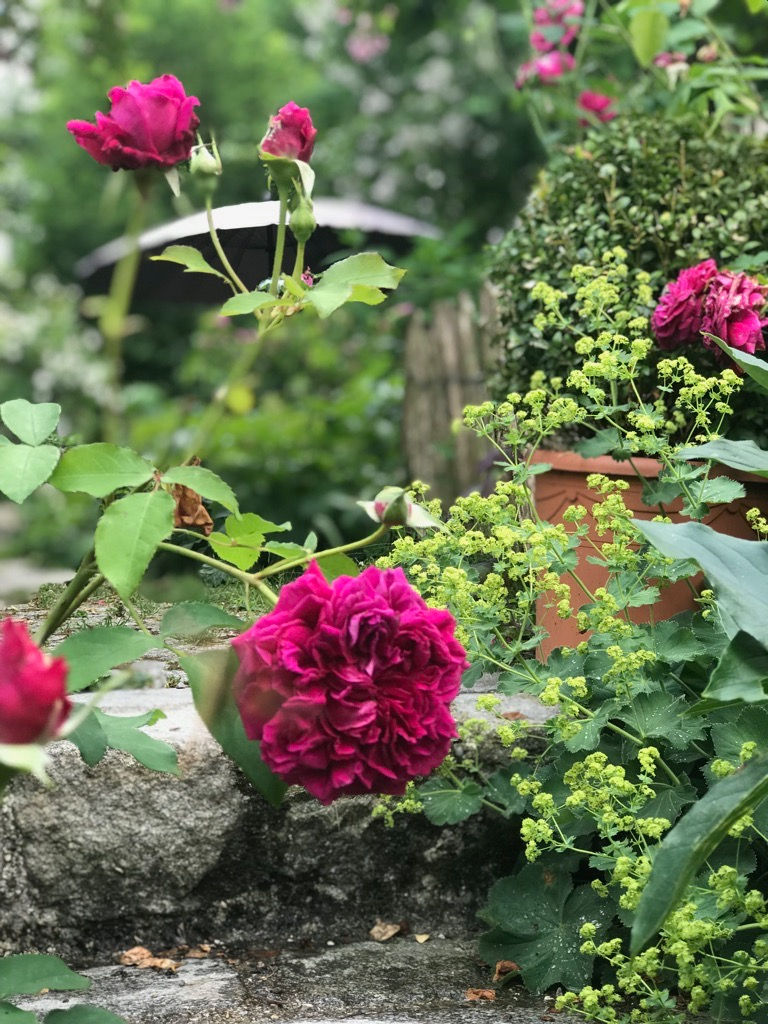PRUNE YOUR ROSES WITH CONFIDENCE | Top tips from an expert that anybody can try
An interview with Christian Schultheis – owner of Germany's oldest rose nursery
Every year, without fail and right before the forsythia starts to flower, I have a short but intense panic attack. It's time to prune the roses.

With over 60 roses (and three kids, a job, a household to run and all the rest of it) you might think it's the amount of time involved that has me in a state of frazzle, but that's not it. In reality, it's that feeling of standing in front of my colorful medley of proud, whimsical and, in many cases, flighty creatures. And they're all waiting and ready to cast an ever so critical eye (in this case a bud eye) over what I'm about to do. I mean, seriously: I've got 'Shakespeare', 'Othello' and even 'Heidi Klum' (yep), all sizing me up...
So, every year I rifle through a selection of various books about roses. Every year I discover that they all say completely different things. And every year, I end up even more confused than I already was.

But: this year is a whole other story! This year I'll know. Because I'm about to ask one of Germany's top rose experts: Christian Schultheis.
mycottagegarden: Mr. Schultheis, your family has been running the oldest rose nursery in Germany for five generations and you are in charge of a sea of roses. What do you do when the forsythia starts to flower? Do all your roses have perfect, outward-facing bud eyes?
Christian Schultheis: I wish! Along with the rose bushes in our garden, we also prune a ton of container roses. Sadly, they don't all have lovely, outward-facing bud eyes (wouldn't that be nice). If we were to cut all of our roses with a perfect diagonal line above an outward-facing bud eye – textbook style – we'd never be finished. That's why we focus most of our attention on cutting to the right height and pruning away any thin rose shoots (everything thinner than a pencil).
mcg: And why is all of this connected to when your forsythia flowers? What makes this the best time to prune?
ChS: When the forsythia starts to flower, it's a pretty good indication that there won't be another hard frost. It's a good rule of thumb because, obviously, the perfect pruning time will vary slightly, depending on your location. For example, if you live close to sea level it will be earlier than it would be at higher altitudes.

mcg: Rose pruning is a topic that fills chapters after chapter, never mind entire books dedicated to the craft. Hybrid tea roses, small bush roses, old roses, climbing roses, shrub roses, ramblers, repeat-flowering varieties and single-flowering varieties – they all need to be treated differently. Can you offer us a few essential tips and tricks of the trade?
ChS: If you want to be able to prune correctly, it's essential that you know what kind of rose you're dealing with. Hybrid tea roses, small bush roses and miniature roses should be cut back to about 15cm. We only pay attention to the position of the eyes in very delicate hybrid tea roses. For bushy varieties, it's sufficient to pay attention to the height you're cutting back to. When it comes to English roses, modern shrub roses and historical roses, these should be cut back by about a third but no more than to half their height. Remove branches that are growing into each other and those that are too reedy and you should end up with a kind of dome shape. Climbing roses can deal with being pruned back by about a third. What you should pay attention to though is to cut according to the way/direction you want them to grow. Horizontal shoots blossom most abundantly. For rambler roses that bloom multiple times, you should cut out any strongly branched shoots and then prune back by about a third. How you cut large rambler roses is entirely up to you – what bothers you comes off.
mcg: I often get questions from worried readers, afraid of doing something wrong when they prune their roses. Is it actually possible to go really really terribly wrong?
ChS: No. You can't completely kill your roses by cutting them wrongly. Worst-case scenario, your roses just won't flower that well and they'll sprout lots of young shoots. It would be much worse not to prune them at all! That causes your roses to age over the years and you'll increasingly see less new growth.

mcg: And if I have absolutely no idea which category my rose falls into (if, for example, I inherited it when I moved into a new home)? Is there a way of staying on the safe side?
ChS: If you stick with the 'one third cut' you'd do on a shrub rose, you can't really go wrong. Any rose will flower happily if you do that. A lot of people prune small bush roses as if they were shrub roses. And, to be honest, they still look pretty magnificent.
mcg: My shrub roses sometimes only really flower at the top and are quite bare underneath. Do you think it's worth risking a rejuvenation prune?
ChS: If you cut back by a third each year, they should develop more young, leafy shoots. If they don't, you can always cut a few of the old shoots back quite heavily. And if the entire shrub starts to look shriveled, bare and downright sad it might be time to take radical action: at the end of June, once the main flowering period has ended, cut all the shoots right back. Come autumn, your shrub will have grown back with plenty of young shoots.

mcg: I have a few roses that, without fail, get black spot, rose rust or mildew every year. Do I need to clean my cutting tools before I use them to cut my healthy roses?
ChS: It definitely wouldn't hurt. Disinfect your shears by placing them in alcohol for three minutes and then hold them over a flame. However, these three fungi are actually leaf diseases and are mainly spread by the air and water droplets.
mcg: Some of my roses don't lose their leaves over the winter and then they end up looking pretty unsightly. Should I take them off or leave them be?
ChS: Like with many things, hygiene is a top priority. After you've finished pruning, remove all the old leaves from your roses and get rid of them. The same goes for roses that still have nice looking leaves left over at the end of winter. Come summer, old leaves are always an infection risk. You don't want there to be any leaves left lying around on the ground either, so make sure to gather them all up. Be aware that bark mulch around your roses can also increase the risk of diseases.

mcg: And now for probably the hardest question. If you were on a desert island (with the perfect rose-growing climate, of course) – which three roses would you take and why?
ChS: That's an easy one to answer. Rose 'de Resht', 'Charles de Mills' and 'Belle sans Flatterie'. They could grow wild and survive without a lot of care. On a desert island I'd presumably have more important things to do than look after roses 😉
mcg: Right then, I'm going to grab my shears (and my big girl pants) and head out into the garden. Thank you oh so very much!
If you happen to live in Germany, head over to Schultheis Rose Nursery for beautiful roses & outstanding advice.
Photos: My Cottage Garden



















Commenti